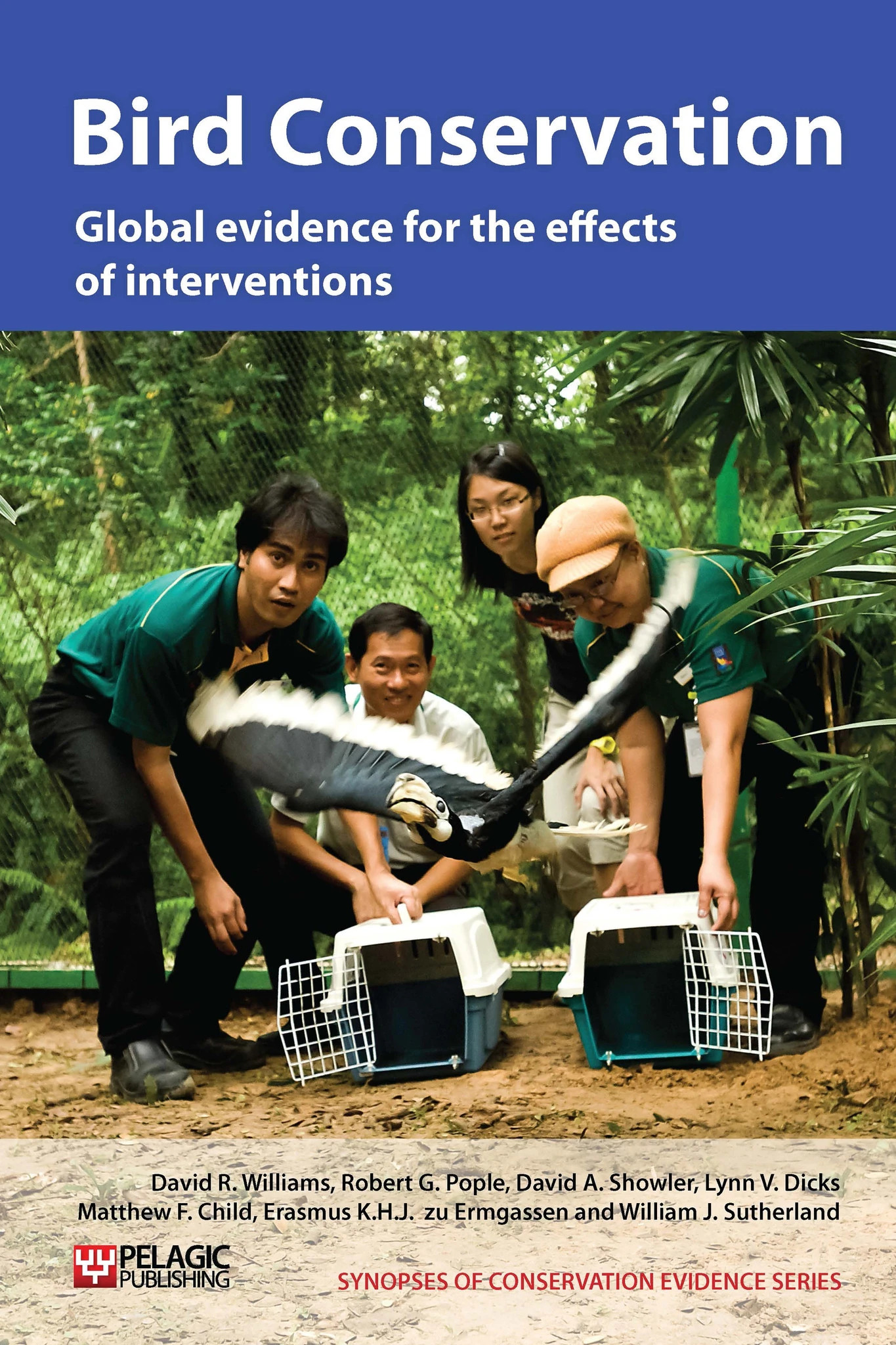Actions to conserve biodiversity
We have summarised evidence from the scientific literature about the effects of actions to conserve wildlife and ecosystems.
Review the evidence from the studies
Not sure what Actions are? Read a brief description.
Search for evidence
e.g. "frogs chytrid"
454 Actions found
Refine
Hide
454 Actions found
Download Actions
| 0 selected |
|
Order results by:
| Action | Effectiveness | Studies | Category | |
|---|---|---|---|---|
|
Clean nest boxes to increase occupancy or reproductive success Action Link |
Likely to be beneficial | 10 |
|
|
|
Use differently-coloured artificial nests Action Link |
Unknown effectiveness (limited evidence) | 1 |
|
|
|
Provide nesting material for wild birds Action Link |
Unknown effectiveness (limited evidence) | 2 |
|
|
|
Repair/support nests to support breeding Action Link |
Unknown effectiveness (limited evidence) | 1 |
|
|
|
Artificially incubate eggs or warm nests Action Link |
Unknown effectiveness (limited evidence) | 2 |
|
|
|
Provide nesting habitat for birds that is safe from extreme weather Action Link |
Unknown effectiveness (limited evidence) | 3 |
|
|
|
Remove vegetation to create nesting areas Action Link |
Unknown effectiveness (limited evidence) | 6 |
|
|
|
Guard nests to increase nest success Action Link |
Unknown effectiveness (limited evidence) | 4 |
|
|
|
Foster eggs or chicks of gannets and boobies with wild conspecifics Action Link |
Unknown effectiveness (limited evidence) | 1 |
|
|
|
Foster eggs or chicks of waders with wild conspecifics Action Link |
Unknown effectiveness (limited evidence) | 3 |
|
|
|
Foster eggs or chicks of vultures with wild conspecifics Action Link |
Unknown effectiveness (limited evidence) | 2 |
|
|
|
Foster eggs or chicks of raptors with wild conspecifics Action Link |
Likely to be beneficial | 11 |
|
|
|
Foster eggs or chicks of owls with wild conspecifics Action Link |
Unknown effectiveness (limited evidence) | 2 |
|
|
|
Foster eggs or chicks of cranes with wild conspecifics Action Link |
Unknown effectiveness (limited evidence) | 1 |
|
|
|
Foster eggs or chicks of bustards with wild conspecifics Action Link |
Unknown effectiveness (limited evidence) | 1 |
|
|
|
Foster eggs or chicks of woodpeckers with wild conspecifics Action Link |
Unknown effectiveness (limited evidence) | 3 |
|
|
|
Foster eggs or chicks of parrots with wild conspecifics Action Link |
Unknown effectiveness (limited evidence) | 2 |
|
|
|
Foster eggs or chicks of petrels and shearwaters with wild non-conspecifics (cross-fostering) Action Link |
Unknown effectiveness (limited evidence) | 1 |
|
|
|
Foster eggs or chicks of waders with wild non-conspecifics (cross-fostering) Action Link |
Unknown effectiveness (limited evidence) | 2 |
|
|
|
Foster eggs or chicks of ibises with wild non-conspecifics (cross-fostering) Action Link |
Unknown effectiveness (limited evidence) | 1 |
|
|
|
Foster eggs or chicks of cranes with wild non-conspecifics (cross-fostering) Action Link |
Unknown effectiveness (limited evidence) | 2 |
|
|
|
Foster eggs or chicks of songbirds with wild non-conspecifics (cross-fostering) Action Link |
Likely to be beneficial | 2 |
|
|
|
Provide supplementary food Action Link |
Awaiting assessment | 1 |
|
|
|
Provide supplementary food for petrels to increase reproductive success Action Link |
Unknown effectiveness (limited evidence) | 1 |
|
|
|
Provide supplementary food for gannets and boobies to increase reproductive success Action Link |
Unknown effectiveness (limited evidence) | 2 |
|
Download Actions
| 0 selected |
|

Bird Conservation - Published 2013
Bird Synopsis
Watch this search
If you are familiar with RSS feeds, please click the button below to retrieve the feed URL:
RSS feed for this searchIf you are unfamiliar with RSS feeds, we would suggest reading this BBC article.
Unfortunately, due to the number of feeds we have available, we cannot provide e-mail updates. However, you could use tools such as Feed My Inbox to do this for you.
What are 'Individual studies' and 'Actions'?
Individual studies
An individual study is a summary of a specific scientific study, usually taken from a scientific journal, but also from other resources such as reports. It tells you the background context, the action(s) taken and their consequences.
If you want more detail please look at the original reference.
Actions
Each action page focuses on a particular action you could take to benefit wildlife or ecosystems.
It contains brief (150-200 word) descriptions of relevant studies (context, action(s) taken and their consequences) and one or more key messages.
Key messages show the extent and main conclusions of the available evidence. Using links within key messages, you can look at the paragraphs describing each study to get more detail. Each paragraph allows you to assess the quality of the evidence and how relevant it is to your situation.
Where we found no evidence, we have been unable to assess whether or not an intervention is effective or has any harmful impacts.





)_2023.JPG)














